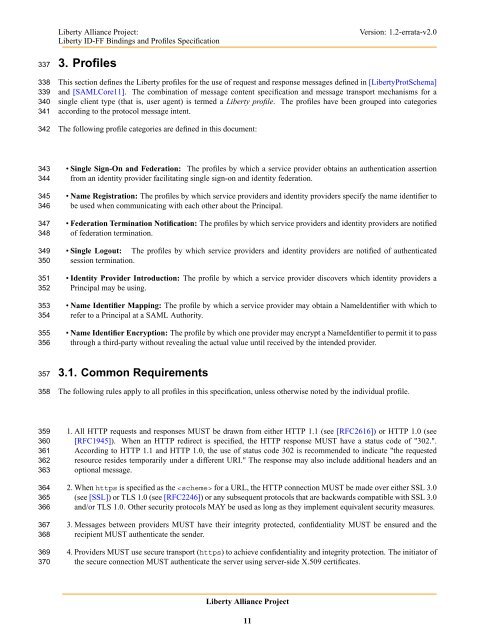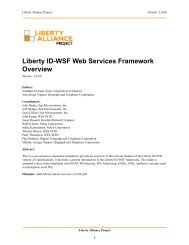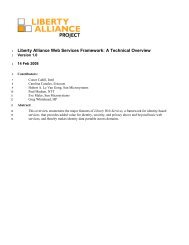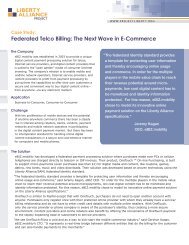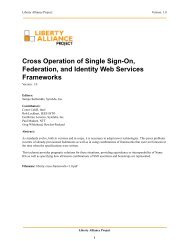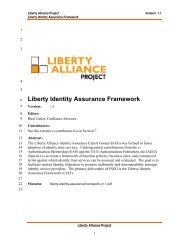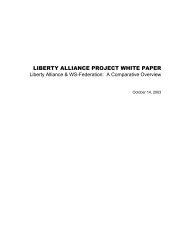Liberty ID-FF Bindings and Profiles Specification - Liberty Alliance
Liberty ID-FF Bindings and Profiles Specification - Liberty Alliance
Liberty ID-FF Bindings and Profiles Specification - Liberty Alliance
You also want an ePaper? Increase the reach of your titles
YUMPU automatically turns print PDFs into web optimized ePapers that Google loves.
<strong>Liberty</strong> <strong>Alliance</strong> Project:<strong>Liberty</strong> <strong>ID</strong>-<strong>FF</strong> <strong>Bindings</strong> <strong>and</strong> <strong>Profiles</strong> <strong>Specification</strong>Version: 1.2-errata-v2.03373383393403413423. <strong>Profiles</strong>This section defines the <strong>Liberty</strong> profiles for the use of request <strong>and</strong> response messages defined in [<strong>Liberty</strong>ProtSchema]<strong>and</strong> [SAMLCore11]. The combination of message content specification <strong>and</strong> message transport mechanisms for asingle client type (that is, user agent) is termed a <strong>Liberty</strong> profile. The profiles have been grouped into categoriesaccording to the protocol message intent.The following profile categories are defined in this document:343344345346347348349350351352353354355356• Single Sign-On <strong>and</strong> Federation: The profiles by which a service provider obtains an authentication assertionfrom an identity provider facilitating single sign-on <strong>and</strong> identity federation.• Name Registration: The profiles by which service providers <strong>and</strong> identity providers specify the name identifier tobe used when communicating with each other about the Principal.• Federation Termination Notification: The profiles by which service providers <strong>and</strong> identity providers are notifiedof federation termination.• Single Logout: The profiles by which service providers <strong>and</strong> identity providers are notified of authenticatedsession termination.• Identity Provider Introduction: The profile by which a service provider discovers which identity providers aPrincipal may be using.• Name Identifier Mapping: The profile by which a service provider may obtain a NameIdentifier with which torefer to a Principal at a SAML Authority.• Name Identifier Encryption: The profile by which one provider may encrypt a NameIdentifier to permit it to passthrough a third-party without revealing the actual value until received by the intended provider.3573583.1. Common RequirementsThe following rules apply to all profiles in this specification, unless otherwise noted by the individual profile.3593603613623633643653663673683693701. All HTTP requests <strong>and</strong> responses MUST be drawn from either HTTP 1.1 (see [RFC2616]) or HTTP 1.0 (see[RFC1945]). When an HTTP redirect is specified, the HTTP response MUST have a status code of "302.".According to HTTP 1.1 <strong>and</strong> HTTP 1.0, the use of status code 302 is recommended to indicate "the requestedresource resides temporarily under a different URI." The response may also include additional headers <strong>and</strong> anoptional message.2. When https is specified as the for a URL, the HTTP connection MUST be made over either SSL 3.0(see [SSL]) or TLS 1.0 (see [RFC2246]) or any subsequent protocols that are backwards compatible with SSL 3.0<strong>and</strong>/or TLS 1.0. Other security protocols MAY be used as long as they implement equivalent security measures.3. Messages between providers MUST have their integrity protected, confidentiality MUST be ensured <strong>and</strong> therecipient MUST authenticate the sender.4. Providers MUST use secure transport (https) to achieve confidentiality <strong>and</strong> integrity protection. The initiator ofthe secure connection MUST authenticate the server using server-side X.509 certificates.<strong>Liberty</strong> <strong>Alliance</strong> Project11


